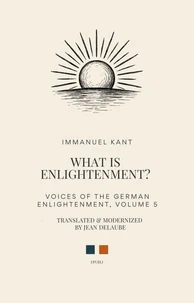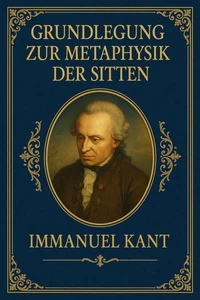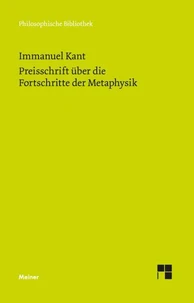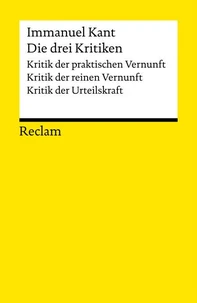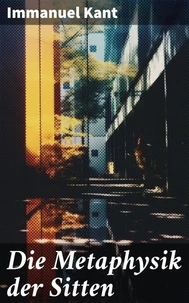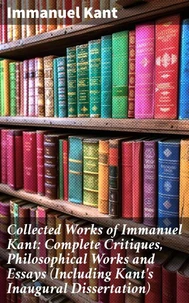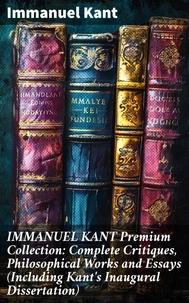The Critique of Judgment: Theory of the Aesthetic Judgment and Theory of the Teleological Judgment. Exploring Beauty and Purpose: Kant's Aesthetic and Teleological Inquiry
Par : ,Formats :
Disponible dans votre compte client Decitre ou Furet du Nord dès validation de votre commande. Le format ePub est :
- Compatible avec une lecture sur My Vivlio (smartphone, tablette, ordinateur)
- Compatible avec une lecture sur liseuses Vivlio
- Pour les liseuses autres que Vivlio, vous devez utiliser le logiciel Adobe Digital Edition. Non compatible avec la lecture sur les liseuses Kindle, Remarkable et Sony
 , qui est-ce ?
, qui est-ce ?Notre partenaire de plateforme de lecture numérique où vous retrouverez l'ensemble de vos ebooks gratuitement
Pour en savoir plus sur nos ebooks, consultez notre aide en ligne ici
- Nombre de pages423
- FormatePub
- ISBN859-65--4780496-3
- EAN8596547804963
- Date de parution08/01/2024
- Protection num.Digital Watermarking
- Taille757 Ko
- Infos supplémentairesepub
- ÉditeurGOOD PRESS
Résumé
In "The Critique of Judgment, " Immanuel Kant embarks on a profound exploration of aesthetic and teleological judgments, positioning his work as a bridge between the empirical and the rational. Divided into two main sections, the text delves into the nature of beauty, the sublime, and how such experiences resonate with human cognition. Through a meticulous analytical style, Kant examines the interrelation between our sensory experiences and the principles of artistic judgment, while his teleological discussions reflect on the meaningfulness of nature's forms.
This work not only situates itself in the philosophical debates of the Enlightenment but also lays foundational ideas that would influence subsequent aesthetic theory and metaphysics. Immanuel Kant, a towering figure in Western philosophy, sought to reconcile the complexities of human experience with rational thought. His background in metaphysics and epistemology, profoundly shaped by the Enlightenment'Äôs quest for knowledge, propelled him toward the inquiries presented in this text.
Drawing upon diverse influences, from Humean skepticism to the rationalistic tendencies of his predecessors, Kant's critical philosophy reflects an attempt to articulate a systematic understanding of human perception and value. For readers interested in the convergence of aesthetics, philosophy, and the human experience, "The Critique of Judgment" is an indispensable text. Kant'Äôs insights not only challenge established norms but invite deep reflection on the nature of beauty and purpose in art and existence.
This book is crucial for understanding the evolution of aesthetic theory, making it essential reading for scholars, students, and anyone curious about the intricacies of judgment and meaning.
This work not only situates itself in the philosophical debates of the Enlightenment but also lays foundational ideas that would influence subsequent aesthetic theory and metaphysics. Immanuel Kant, a towering figure in Western philosophy, sought to reconcile the complexities of human experience with rational thought. His background in metaphysics and epistemology, profoundly shaped by the Enlightenment'Äôs quest for knowledge, propelled him toward the inquiries presented in this text.
Drawing upon diverse influences, from Humean skepticism to the rationalistic tendencies of his predecessors, Kant's critical philosophy reflects an attempt to articulate a systematic understanding of human perception and value. For readers interested in the convergence of aesthetics, philosophy, and the human experience, "The Critique of Judgment" is an indispensable text. Kant'Äôs insights not only challenge established norms but invite deep reflection on the nature of beauty and purpose in art and existence.
This book is crucial for understanding the evolution of aesthetic theory, making it essential reading for scholars, students, and anyone curious about the intricacies of judgment and meaning.
In "The Critique of Judgment, " Immanuel Kant embarks on a profound exploration of aesthetic and teleological judgments, positioning his work as a bridge between the empirical and the rational. Divided into two main sections, the text delves into the nature of beauty, the sublime, and how such experiences resonate with human cognition. Through a meticulous analytical style, Kant examines the interrelation between our sensory experiences and the principles of artistic judgment, while his teleological discussions reflect on the meaningfulness of nature's forms.
This work not only situates itself in the philosophical debates of the Enlightenment but also lays foundational ideas that would influence subsequent aesthetic theory and metaphysics. Immanuel Kant, a towering figure in Western philosophy, sought to reconcile the complexities of human experience with rational thought. His background in metaphysics and epistemology, profoundly shaped by the Enlightenment'Äôs quest for knowledge, propelled him toward the inquiries presented in this text.
Drawing upon diverse influences, from Humean skepticism to the rationalistic tendencies of his predecessors, Kant's critical philosophy reflects an attempt to articulate a systematic understanding of human perception and value. For readers interested in the convergence of aesthetics, philosophy, and the human experience, "The Critique of Judgment" is an indispensable text. Kant'Äôs insights not only challenge established norms but invite deep reflection on the nature of beauty and purpose in art and existence.
This book is crucial for understanding the evolution of aesthetic theory, making it essential reading for scholars, students, and anyone curious about the intricacies of judgment and meaning.
This work not only situates itself in the philosophical debates of the Enlightenment but also lays foundational ideas that would influence subsequent aesthetic theory and metaphysics. Immanuel Kant, a towering figure in Western philosophy, sought to reconcile the complexities of human experience with rational thought. His background in metaphysics and epistemology, profoundly shaped by the Enlightenment'Äôs quest for knowledge, propelled him toward the inquiries presented in this text.
Drawing upon diverse influences, from Humean skepticism to the rationalistic tendencies of his predecessors, Kant's critical philosophy reflects an attempt to articulate a systematic understanding of human perception and value. For readers interested in the convergence of aesthetics, philosophy, and the human experience, "The Critique of Judgment" is an indispensable text. Kant'Äôs insights not only challenge established norms but invite deep reflection on the nature of beauty and purpose in art and existence.
This book is crucial for understanding the evolution of aesthetic theory, making it essential reading for scholars, students, and anyone curious about the intricacies of judgment and meaning.


